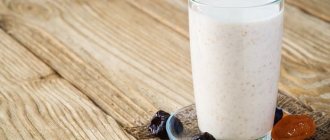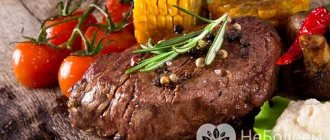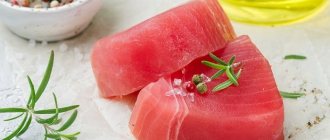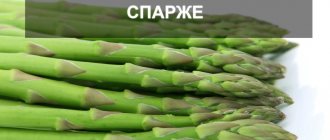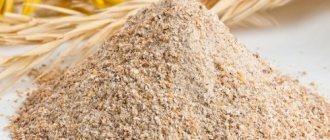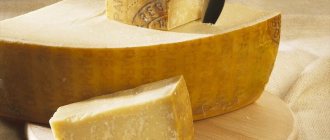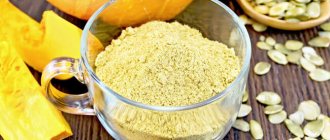Varieties and types of vegetables
| By type of reproduction | |
| Partnerocarpic (hybrid) | The fruits set without pollination and have no seeds. |
| Self-pollinating (hybrid) | They are pollinated by stamens and pistils. |
| Bee-pollinated | They reproduce only through pollination by bees. |
| To size | |
| Pikuli | fruits that have just begun to set; length - from 3 to 5 cm. |
| Gherkins | Longer fruits (from 5 to 9 cm). |
| Salad | Long and crispy fruits with smooth skin; grown specifically for adding to salads or as a snack. |
| For pickling | Cucumbers are small in size and of suitable hardness for rolling into jars. |
| Universal | The fruits can be consumed both fresh and canned. They have a long shelf life. |
There are also varieties of cucumbers depending on the growing conditions (open or closed ground, in a greenhouse or outdoors).
There are a lot of varieties, the most popular among them are:
- “Bush” - has hard, pimply fruits; not susceptible to diseases and resistant to adverse weather conditions, grown in open ground.
- “Tom Thumb” - grown in a greenhouse; It is characterized by a rapid growth rate and ripeness of fruits, and is not susceptible to disease. It can produce both tasty gherkins and longer fruits. Most often, this variety is used for pickling and canning.
- “Benefit F1” - the fruits ripen 45-50 days from the beginning of the first shoots. Cucumbers are medium in size, weigh 100-120 g and have a bumpy surface. They are universal.
- “Nezhinsky” - cucumbers ripen late, grow slightly elongated with large pimples. Grown in open ground.
- “Vyaznikovsky” is a drought-resistant variety and most suitable for pickling; does not have high yield.
- “Gypsy” - suitable for growing both in open ground and in greenhouses. The cucumbers are moderately hard and crispy.
- “Arctic” - have a fresh, rich taste and can be grown in outdoor and greenhouse conditions.
- “Tchaikovsky” is an early ripening variety grown in greenhouse conditions. Resistant to diseases.
- “Cupid” has small, moderately hard fruits. It is a universal species, suitable for growing in various conditions.
How to choose a cucumber variety
Currently, there are parthenocarpic and bee-pollinated varieties of cucumbers. Plants of the first type are excellent for cultivation in small greenhouses, since the formation of ovaries occurs without the participation of insects. To cultivate vegetables in open ground, you can use both bee-pollinated and parenocarpic varieties of cucumbers. In addition, when choosing seed, you should take into account the intended purpose of the fruit: for preservation or fresh consumption.
Interestingly, to denote hybrid forms of a plant, the prefix “F1” is added to the name.
Cucumbers (varieties) for open ground:
Instead of bromine - cucumber. Interestingly, in ancient times, the seeds and unripe fruits of the vegetable were used to relieve sexual arousal. That is why cucumbers were grown in large quantities on the monastery farmsteads.
The great commander Napoleon revered the green vegetable so much that he announced a reward equivalent to 250 thousand dollars to the one who could come up with a way to increase the shelf life of the product during campaigns. Unfortunately, the method of prolonging the freshness of the fruit was not obtained not in the 18th century, not to this day.
F1 cucumbers for greenhouses:
Advantages of the variety: shade tolerance, high yield, disease resistance. The weight of one cucumber is 130 g.
Remember, when choosing a cucumber variety, you should take into account the region of cultivation, climatic conditions, as well as the intended purpose of the product.
Calorie content, BJU
Cucumber, whose benefits and harm to the body depend on its chemical composition, contains about 95% water.
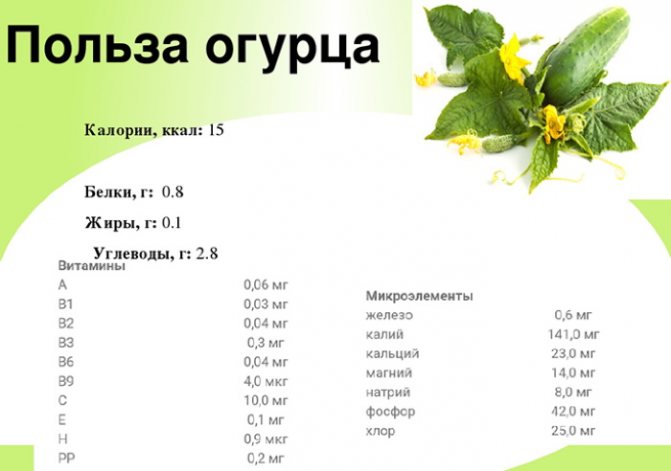
The remaining 5% comes from BJU and other nutrients:
| Nutrient | Content per 100 g |
| Squirrels | 0.7 g |
| Fats | 0.1 g |
| Carbohydrates | 2.4 g |
| Cellulose | 1 g |
| Ash | 0.5 g |
| Pectins | 0.4 g |
| Organic acids | 0.1 g |
| Starch | 0.1 g |
Cucumbers also contain a large amount of vitamins, micro- and macroelements. The vegetable is especially rich in potassium, which is necessary for the normal functioning of the cardiovascular system. The calorie content of cucumbers per 100 g is 15 Kcal. For different varieties and types of cucumbers, the calorie content and chemical composition may vary slightly.
What's the calorie content?
Due to the fact that it contains practically no fats, proteins and carbohydrates, there are extremely few calories. So, there are only 15 calories in 100 grams.
For 100 grams of fresh cucumbers there are:
- 0.8 proteins
- 0.1 fat
- 3.0 carbohydrates
This means that you can safely eat cucumbers without limiting yourself in quantity for fear of gaining excess weight. In addition, thanks to cucumbers, the formation of fats from carbohydrates in the body is inhibited. This indicates an active fight against excess weight. In order to quickly and effectively cleanse the stomach, you need to eat a fresh cucumber, and then wash it down with a glass of cold water or milk. The laxative effect will not be long in coming, which means the stomach will quickly clear.
Video
Of course, the calorie content depends on the form in which it is eaten. How many calories are in a cucumber (fresh, lightly salted) depends on the cooking method. Although there is a small difference, there is a difference in whether the cucumber is salted, lightly salted, pickled or greenhouse. For a more accurate determination of calorie content, we suggest that you familiarize yourself with the table.
In the table you can find out how many kcal are in a cucumber per 100 grams
| Product | Calories, in kcal |
| salted cucumber calories | 11,0 |
| calorie content of greenhouse cucumber | 10,0 |
| calorie content of lightly salted cucumber | 14,0 |
| calorie content of pickled cucumber | 16,0 |
In addition, its energy value also varies.
Video
Nutritional value table, per 100 grams of product:
| Cucumber | Squirrels, gr. | Fats, gr. | Carbohydrates, gr. |
| salty | 0,8 | 0,1 | 1,7 |
| greenhouse | 0,7 | 0,0 | 1,8 |
| lightly salted | 0,8 | 0,1 | 1,9 |
| marinated | 2,8 | 0,0 | 1,3 |
In order to use the most non-calorie cucumbers for food, there are several recipes. They allow you to use the vegetable most rationally.

Hearty and tasty salad
To prepare this dish you will need:
- 300 grams of cucumbers
- 50 milliliters vegetable oil
- 15 milliliters vinegar
- 1 teaspoon mustard
- Salt to taste
- Onion
- Dill
Washed cucumbers should be cut into slices and salted. Then they need to be poured with vegetable oil, which is mixed with mustard and vinegar. Add dill on top. After mixing the salad, you need to leave it in the refrigerator for 10 minutes. Before serving, you can sprinkle leeks on top for taste and beauty.
Beetroot salad
To prepare this dish you will need more ingredients, in particular:
- 300 grams of cucumbers
- 100 grams of beets
- 1 teaspoon lemon juice
- 50 grams shelled walnuts
- Vegetable oil
- Salt
- Green onion
Raw beets need to be grated. Heat the beets a little in a frying pan, adding lemon juice. After this, you need to cool everything and mix it with cucumbers, pre-cut into rings. This also includes walnuts, finely chopped. Add salt and vegetable oil. If desired, you can season the salad with green onions on top. Such salads are popular not only because of their low calorie content, but also because of their taste, which will not leave anyone indifferent.
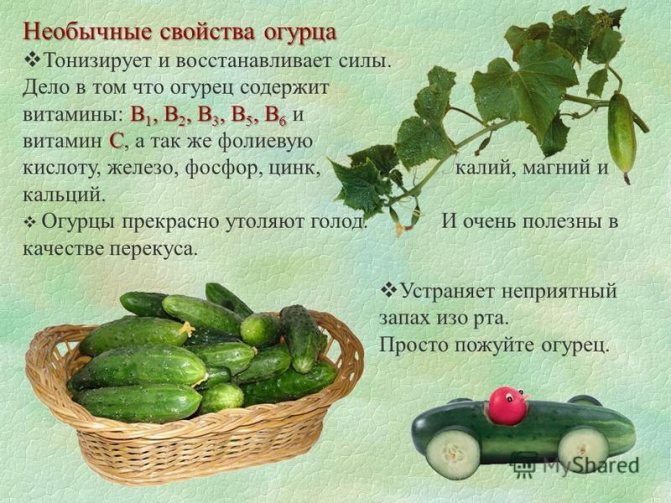
Benefit
The rich chemical composition and very low calorie content allow cucumbers to be classified as dietary products. On a diet, they can be consumed in large quantities. Due to the presence of fiber, the product cleanses the gastrointestinal tract and causes a feeling of fullness, thereby promoting weight loss.
And the water contained in cucumbers is different from ordinary water - it is purer and more structured and perfectly fills the body with moisture.

Cucumber. Benefits and harms for the body. It has much more benefits.
The vegetable also has the following beneficial properties:
- Normalizes digestion . The fiber in cucumbers enhances intestinal motility and gently relieves constipation.
- Has a diuretic effect . Due to their high water content, vegetables gently remove excess water from the body and eliminate swelling.
- Cleanses the body . When it enters the body, cucumber juice dissolves toxins and wastes, as well as heavy metal salts and removes them through the kidneys.
- Is a source of vitamins and minerals . Daily consumption of cucumbers (pure or as part of salads, smoothies) will help saturate the body with the necessary nutrients.
- Has anti-cancer effects. Cucumbers contain antioxidants - substances that destroy free radicals and prevent the formation of tumors. Also, the antioxidant properties of the product help maintain the youth of the body and skin. And recent studies have shown that the substance that gives cucumber its bitterness, cucurbitacin, has the ability to suppress the growth of cancer cells.
- Improves the cardiovascular system . Due to the presence of potassium, eating cucumbers helps strengthen the heart muscle and blood vessels. Studies have also shown that the product has the ability to regulate blood pressure and cleanse blood vessels of “bad” cholesterol, preventing the development of atherosclerosis.
- Contains silicon . This mineral is essential for healthy hair, skin and nails. It is also responsible for the strength of blood vessels and connective tissues of the body and helps in the absorption of certain other minerals by the body.
- Good for vision . Cucumbers are rich in lutein and zeaxanthin - substances that help maintain visual acuity and protect the retina from harmful radiation. Lack of lutein and zeaxanthin can lead to cataracts and vision loss.
- Reduces blood sugar levels . This makes cucumber an essential food for those who have diabetes. The vegetable promotes the production of insulin by the pancreas and lowers blood sugar.
- Improves the absorption of BZHU. Cucumbers are recommended to be consumed together with meat, as they help animal proteins to be better absorbed in the body. The product also prevents the conversion of carbohydrates into fats, preventing weight gain.
- Helps with lung diseases . To improve sputum discharge and cure cough, the patient should be given fresh cucumber juice mixed with honey, 50 ml 3 times a day.
- Freshens breath. Instead of chewing gum, you can place a slice of cucumber in your mouth - the substances contained in it will kill bacteria that cause an unpleasant odor.
- of vitamin C. Cucumbers also (but in smaller quantities) contain ascorbic acid, which helps strengthen the immune system. The greatest amount of acid is found in small fruits, and as they ripen and grow, the level of the substance in them decreases.
- Helps with heartburn . For this pathology, it is recommended to eat a small amount of grated cucumber - after a while the symptoms will subside.

The greatest benefits come from self-grown cucumbers - you can be sure that such vegetables do not contain harmful fertilizers. When using them for food, it is not recommended to remove the skin from them, since this is where most of the useful components accumulate.
Cucumber
Cucumber is an annual plant belonging to the cucurbit family.
The main part of the ingredient composition of the vegetable is water (95%). This is a low-calorie product containing only 14 kcal per 100 g. In view of this, many weight loss programs (strict and combined) have been developed based on cucumber, designed for both emergency weight loss within 3 days and systematic weight correction over 1 month. This is a source of hard-to-digest fiber, vitamins, mineral compounds, proteins, organic acids, which helps cope with constipation and removes cholesterol from the body. Interestingly, in terms of thiamine content, cucumbers are ahead of beets (0.03 mg versus 0.02 mg), and radishes are ahead of riboflavin (0.04 mg versus 0.03 mg).
The vegetable satisfies the feeling of hunger, reduces the severity of edema, maintains normal thyroid function, increases vitality, improves the appearance of the skin, and increases the elasticity of blood vessels. In addition, polyphenolic structures were found in the pulp of cucumbers, which minimize the likelihood of developing cancer of the uterus, prostate, breast and ovaries.
Harm and contraindications
Cucumber (the benefits and harm to the body also depend on the amount of consumption) is allowed without restrictions only to healthy people, as it has several harmful properties. Because of them, the vegetable is completely contraindicated for some people, while for others it is allowed with restrictions.
The product tends to increase the acidity of gastric juice, which is why it is contraindicated for people with gastritis with high acidity and peptic ulcers of the stomach or intestines. For diarrhea, cucumbers are completely contraindicated, as they improve intestinal motility and only aggravate the problem. If there is a tendency to such a pathology, then the consumption of cucumbers should be limited.
Pregnant women are not recommended to eat too many cucumbers to avoid swelling, which women are already prone to during this period. Nursing mothers should also limit their consumption of cucumbers to a few pieces per week, otherwise the baby may experience diarrhea.
Also, due to the high level of water content, cucumbers are not recommended in large quantities for people with kidney pathologies (since the main function of the kidneys is to remove water from the body, and with a large volume of fluid passing through them, the disease can worsen).
Hypotonics (people with low blood pressure) should limit the consumption of cucumbers, as they tend to lower blood pressure.
Iodine, contained in considerable quantities in cucumbers, can harm people with thyroid pathologies, so you can include the product in your diet only after consulting your doctor.

Salted and pickled cucumbers are not recommended for people who have:
- pathologies of the cardiovascular system (since salt causes swelling and increased blood pressure);
- gastrointestinal diseases (brines and marinades additionally irritate the gastric mucosa, aggravating the course of the disease);
- diseases of the biliary system (hepatitis, cholecystitis);
- diseases of the urinary system (pyelonephritis, urolithiasis, renal failure, since salt has an additional negative effect on the kidneys).
Cucumber (the benefits and harm to the body may depend on the time of consumption) should not be eaten in large quantities in the evening - otherwise in the morning you may wake up with swelling due to the accumulation of fluid in the body.
Cucumbers collected in winter and spring can be very harmful to the body, as they contain large amounts of nitrates and fertilizers. Before eating such vegetables, it is necessary to remove the skin and edges from them, since, in addition to useful substances, fertilizers accumulate there.
For whom the product is harmful, contraindications for use

But besides the benefits, passion for vegetables leads to undesirable consequences:
- The presence of an ulcer in the stomach or duodenum is a contraindication for eating greens. The acids they contain can increase pain.
- Cucumbers are contraindicated for patients with high stomach acidity.
- Since the vegetable has some diuretic effect, it should not be consumed by those who have kidney stones. Consuming the product in large quantities will lead to the movement of formations and blockage of the ureters.
- For inflammation of the intestinal mucosa, cucumber can aggravate the patient's condition. The pain will become more pronounced.
- There are prohibitions on eating cucumbers in case of chronic and acute nephritis, chronic renal failure. They are contraindicated in patients with pyelocystitis, which is accompanied by an alkaline urine reaction.
- Pickles are harmful to patients with kidney dysfunction. And for pregnant women, they are dangerous because they increase appetite, contributing to excess weight gain.
- It is forbidden to give cucumbers to small children under six months old. A vegetable that is poorly processed by the intestines will cause severe abdominal pain and cause increased gas formation.
Before switching to a cucumber diet, you should consult a specialist about its benefits.
Menu for PP
Healthy people who have no contraindications should regularly include cucumbers in their diet. You can also arrange a 7-day cucumber diet, which will help cleanse the body, eliminate swelling and lose 2-3 kg by removing fluid. The diet menu does not imply eating cucumbers exclusively for a week and fasting. It allows you to eat a balanced and varied diet.
Monday
Menu:
- Breakfast: smoothie made from cucumber, celery and apple. If the mixture is too thick, you can add a little water to make it easier to drink.
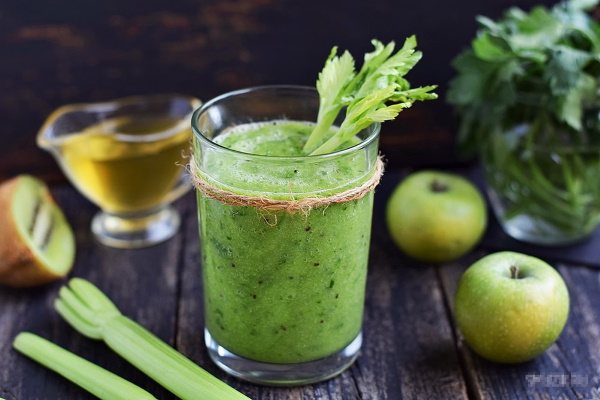
- Snack : any fruit.
- Lunch : any low-fat soup with several pieces of rye bread, for the main course - boiled poultry + any low-fat side dish (buckwheat, rice) + vegetable salad (with the addition of cucumber).
- Afternoon snack : 150 g of cottage cheese or 1 apple or 1 cucumber.
- Dinner : baked low-fat fish with lemon and spices.
Tuesday
Menu:
- Breakfast: rice or buckwheat porridge with water (if desired, you can eat a few pieces of whole grain bread).
- Snack: Sandwich made with whole grain bread, cucumber and cheese.
- Lunch: boiled pasta + steamed chicken cutlet + vegetable salad (optional without adding cucumber).
- Afternoon snack: a glass of kefir or fermented baked milk, or unsweetened fruit.
- Dinner: vegetable salad of tomatoes and cucumbers, sprinkled with vegetable oil.
Wednesday
Menu:
- Breakfast: omelet or scrambled eggs from 2-3 eggs + cucumber salad + a piece of whole grain bread.

- Snack: 1 orange.
- Lunch: any low-fat soup with several pieces of rye bread; for the main course - boiled rice with baked fish and a salad of cucumbers and herbs.
- Afternoon snack: 10-15 nuts; can be replaced with a small amount of dried fruit.
- Dinner: baked chicken breast with herbs and vegetable salad with cucumbers.
Thursday
Menu:
- Breakfast: Cucumber, celery and apple smoothie.
- Snack: cottage cheese with herbs or a sandwich with whole grain bread, cottage cheese and tomato.
- Lunch: stewed cabbage with bell peppers and beef and cucumber salad.
- Afternoon snack: any unsweetened fruit.
- Dinner: baked red fish with beans, carrots and green peas.
Friday
Menu:
- Breakfast: baked avocado (remove the pit from the avocado, pour a raw egg into the resulting cavity and sprinkle with spices, bake until the eggs are ready) and a salad of fresh vegetables with the addition of cucumber.
- Snack: 1 apple.
- Dinner: for the first course - vegetable soup; for the second course - boiled buckwheat + steamed chicken cutlet + several pieces of rye bread.
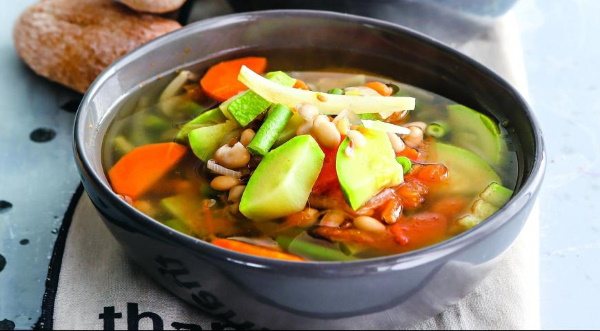
- Afternoon snack: Greek yogurt (can be replaced with regular yogurt, but without fruit and berry fillings).
- Dinner: homemade healthy shawarma (smear thin pita bread with sour cream and garlic sauce, top with boiled chicken breast, sliced cucumber, tomatoes, lettuce and pour sauce over everything; lightly fry on the grill).
Saturday
Menu:
- Breakfast: oatmeal with water (can be sweetened with honey).
- Snack: smoothie made from 1 cucumber, 1 kiwi and 1 apple.
- Lunch: boiled chicken or turkey + vegetable side dish.
- Afternoon snack: a small amount of nuts or dried fruits.
- Dinner: steamed egg white omelette + several pieces of whole grain bread + tomato and cucumber salad.
Sunday
Menu:
- Breakfast: spread cottage cheese on whole grain bread, place boiled chicken breast, a slice of cucumber and a slice of low-fat hard cheese on top.
- Snack: yogurt or a glass of fermented baked milk.
- Dinner: baked fish with vegetables.
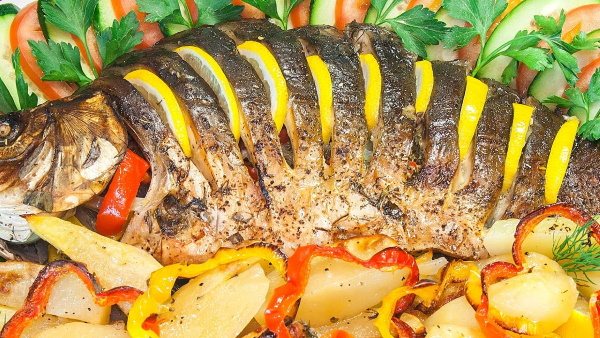
- Afternoon snack: cucumber salad with vegetable oil.
- Dinner: pasta + minced turkey cutlet.
Recommended drinks include herbal teas and infusions, still mineral water, and berry infusions. It is not recommended to drink too much black tea with sugar or coffee. You need to drink at least 1 liter of clean water per day.
How to pickle cucumbers
Currently, this method of processing vegetables is the most popular. There are many variations of pickling cucumbers, which differ in the quantitative composition of salt, herbs and spices. There are two ways to prepare vegetables for future use: “cold” (without sterilization) and hot.
Spices for salting cucumbers (for a three-liter jar):
If desired, add a sprig of tarragon, mint, basil or savory to the bottle.
Hot method of pickling cucumbers
After preservation, the pickles are turned upside down (until they cool completely), wrapped and after a day put away in a cool place.
Recipe for pickled cucumbers using the “cold” method
The optimal storage temperature for the product is 0 degrees.
Secrets of proper salting
Remember, the more vegetables fit in the jar, the longer the product will be stored (due to the increased concentration of lactic acid during fermentation).
To get cucumbers with a crispy crust, it is important to place them exclusively in sterile containers. Remember, in 80% of cases, pickles spoil due to careless preparation of dishes.
Fasting day on cucumber
A cucumber fasting day will help you cleanse your body and lose several kilograms in just a day. There are several options for a fasting day with cucumber, so everyone can choose the type of nutrition for themselves.
Only on cucumbers
This is the simplest option for a fasting day: you need to eat 1-1.5 kg of cucumbers per day. Meals should be divided into 5-6 parts, between which you should drink clean still water. Vegetables can be eaten either as a salad or whole.
Cucumber-apple
This fasting day is suitable for those who do not want to eat only vegetables all day. In addition, fruits also contain fiber, which helps normalize digestion. Unloading involves eating 1 kg of cucumbers and 1 kg of apples per day.
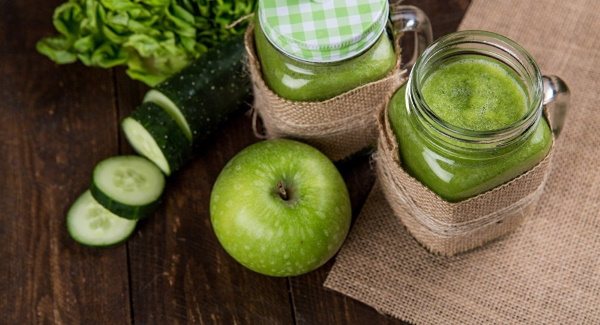
You can prepare a cucumber-apple salad from the products, or eat fresh vegetables and baked fruits. But you need to bake apples without sugar or other additives.
Cucumber-kefir
When choosing this food option, you need to consume 1 kg of vegetables and 1 liter of kefir during the day. Meals should be divided into 5-6 parts, and kefir should be drunk in between. It is also necessary to drink water.
You can make a salad: chop the vegetables and pour a small amount of kefir over them. This salad can be eaten throughout the day or at certain meals (for example, breakfast and dinner).
Cucumber-buckwheat
This food option is very filling - during the day you need to eat steamed buckwheat along with cucumbers.
It is recommended to steam buckwheat, as this allows you to preserve all the beneficial substances inside the grain:
- In the evening, place 250-300 g of cereal in a thermos for food and pour 2 cups of boiling water.
- Close the thermos tightly and insulate it with a towel or blanket.
- Leave the buckwheat to steam overnight.
From the specified amount of buckwheat you will get a large amount of porridge, which needs to be divided into 5-6 doses and consumed together with cucumbers or a salad made from them. For the whole day you will need about 700-800 kg of vegetables. You can also drink green tea without sugar between meals.
On the water Sassi
Sassi water is a drink prepared according to the following recipe:
- Cut a lemon and 2 cucumbers (large size) into circles.
- Tear 10 mint leaves and grate a small amount of ginger root.
- Add all ingredients to 2 liters of clean filtered water and leave to infuse overnight.
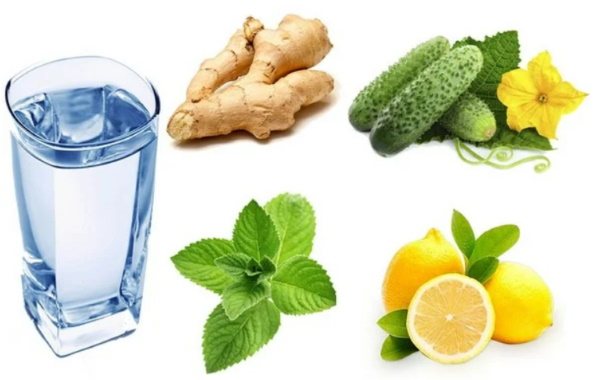
Throughout the next day you need to drink the prepared drink. You can eat cucumbers as a snack. This fasting day option is not suitable for people with problems with the urinary and cardiovascular systems.
A cucumber fasting day can be carried out no more than once every 2-3 weeks, since this type of nutrition is a mono-diet and is not suitable for frequent use.
Chemical composition of fresh cucumbers
Fruits of medium ripeness consist of 97% water and fiber. The remaining 3% is nutrients and chlorophyll. There are almost no proteins, carbohydrates and fats in vegetables, but the content of magnesium, potassium, calcium, phosphorus is high - this is the main thing that fresh cucumber is good for the body.
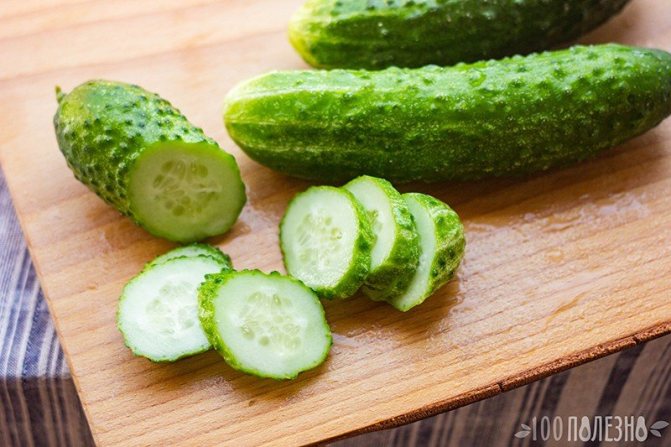
Cucumbers, cut into rings
There is especially a lot of silicon in fruits. Just 100 grams of pulp contain 177% of the daily requirement of this element, which is necessary for the formation of collagen. The benefits of fresh cucumbers for the human body are largely due to their high content. It is he who is responsible for the good condition of hair, nails, and skin.
Of the vitamins, the most abundant are ascorbic acid and vitamin K. Group B vitamins, vitamins A and E are present in small amounts. Of the microelements, the most important are:
- iron,
- copper,
- cobalt,
- chromium,
- zinc,
- selenium.
When to expect an effect
Cucumber (the benefits and harm to the body depend not only on the measure, but also on the frequency of use) should be gradually included in your diet - you should not immediately load up on vegetables, as swelling and some other complications may occur.
The effect of regular consumption of this green vegetable will appear in 1-1.5 months. You will notice that digestion has improved, stools have returned to normal, and swelling has disappeared. For people who have any pathologies for which cucumber helps, the effect will not be very pronounced. But in combination with therapeutic recommendations, regular consumption of cucumbers will help improve the health of the body.
When consuming a vegetable on a fasting day, the effect will appear immediately - excess fluid will leave the body, due to which excess volume and weight will be “burned” (in 1 day you can lose from 1 to 3 kg). The body will also feel lighter and digestion will improve. Cucumber grown with the help of chemicals is not only useless for the body, but also harms it .
When buying vegetables, you need to pay attention to the color of the skin - it should be bright green and matte (too dark a color indicates that the product was grown with chemicals, and a shiny surface means that it was rubbed with wax to give it a marketable appearance). It is also recommended to feel the cucumbers - they should be elastic and dense, but not too hard.
Application in cosmetology
Due to their rich ingredient composition, cucumbers have long been used for cosmetic purposes.
Products based on them have powerful antioxidant, moisturizing, toning, whitening and anti-inflammatory properties. Cucumber compositions are used to eliminate oily shine, lighten age spots (including freckles and dark circles under the eyes), reduce acne, even out skin tone (especially after tanning), narrow surface pores, smooth out fine wrinkles, and moisturize the stratum corneum.
Homemade facial compositions:
In addition, fresh cucumber is used as a single product for the care of oily, pigmented and aging facial skin. To do this, cut the vegetable lengthwise into 2 halves and wipe the dermis with it after makeup removal.
Interestingly, Queen Cleopatra consumed cucumber juice internally and used it externally as masks to maintain youthful skin.
Fresh cucumbers: benefits and harms for weight loss
Low calorie content makes the product suitable for fasting days. This is a good addition to a low-calorie diet. Fruits are actively included in dietary menus. Like other vegetables, the product is seasonal and brings the greatest benefit during the period of natural ripening in the garden beds.
How are cucumbers good for weight loss?
Vegetables are known for their cleansing and also mild laxative effects that do not cause discomfort. Low-calorie fruits satisfy hunger well. They remove harmful substances that have accumulated for a long time.
To lose extra pounds faster, you should not overuse salt. It is limited to 5 grams per day. The most noticeable results will be if you diversify the menu with protein foods, citrus fruits, low-fat, and even better, lactose-free kefir.
For the diet, choose young, tender fruits with small seeds. They are added to salads, okroshka, and combined with cabbage or other vegetables. Detox drinks are prepared from them: juices, fresh juices, smoothies.
Fasting day on cucumbers
The easiest way to feel the rejuvenating properties of vegetables is to have a cucumber fasting day for weight loss. To do this, take one and a half kilograms of the product, divide it into 5 equal parts, which are eaten during the day, preferably without salt.
This is the basis of the daily diet, which can include a couple of eggs, half a pack of low-fat cottage cheese or a piece of boiled beef. In the summer, it is recommended to do such a fasting day on cucumbers once a week, the results of which will immediately be reflected on the scale.
What harm could there be?
Usually the product does not cause allergies or other negative reactions, but even it can cause an unpleasant surprise. Consequences may occur if you exceed the reasonable norm, which is 2 kg per day. Contraindications: liver and kidney diseases in the acute phase, as well as gastritis, ulcers, colitis, diarrhea.


